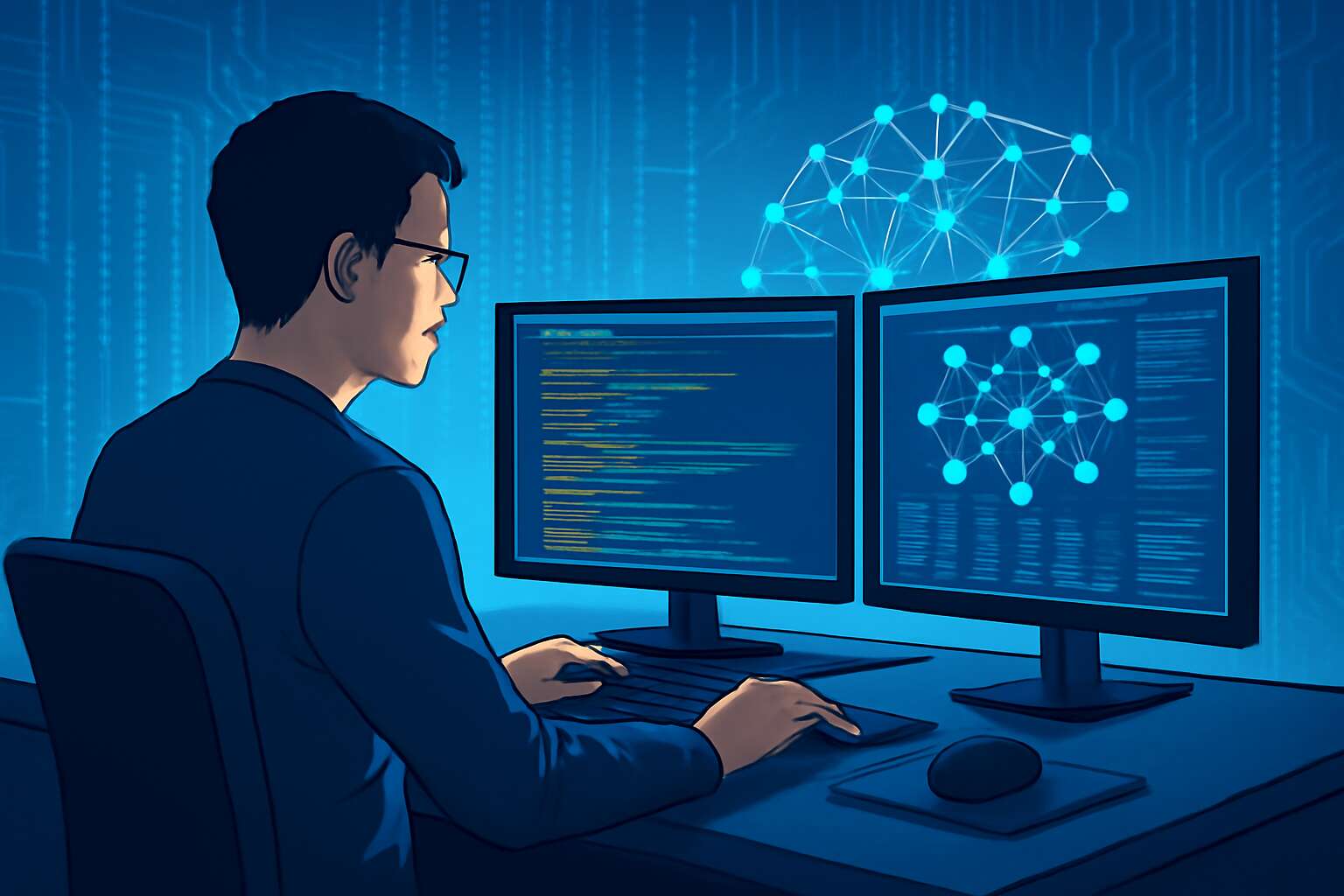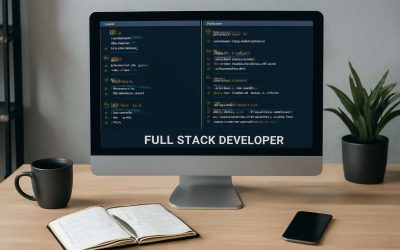Understanding the Role of a Full Stack Developer
The Skills and Responsibilities of a Full Stack Developer
In the realm of technological alchemy, the full stack developer to AI transforms lines of code into living, breathing digital ecosystems. These modern artisans possess a rare blend of skills, navigating seamlessly from the front-end enchantments to the back-end wizardry. Their responsibilities are as diverse as they are vital—crafting intuitive interfaces, managing robust databases, and ensuring the entire system performs with symphonic harmony.
To truly understand the role of a full stack developer in the age of AI, one must appreciate the intricate dance of their skillset. They are often skilled in languages such as JavaScript, Python, and SQL, enabling them to build and optimise applications that can learn and adapt. Their work involves integrating AI models, creating scalable architectures, and ensuring smooth deployment across platforms.
As the landscape shifts, the journey from a traditional full stack developer to AI integration becomes a natural evolution. It involves mastering not just the craft of coding but also embracing new paradigms like machine learning, data analysis, and neural networks—an enchanting voyage into the future of technology.
Key Technologies and Languages Used
In the ever-evolving landscape of technology, understanding the key technologies and languages used by a full stack developer to AI is akin to deciphering the very fabric of digital innovation. These architects of the modern era wield an arsenal of tools that bridge the realm of human ingenuity and machine intelligence. At their core, languages like JavaScript and Python serve as the twin flames igniting the potential of seamless user interfaces and intelligent backend systems.
When delving into AI integration, knowledge of frameworks and libraries becomes paramount. For instance, TensorFlow and PyTorch are the artisans’ brushes for painting neural networks, transforming raw data into insights that mimic cognition. Meanwhile, databases such as PostgreSQL and MongoDB underpin these systems, ensuring data flows as effortlessly as a symphony’s crescendo. To truly master the full stack developer to AI journey, one must embrace these technologies—each a vital thread woven into the complex tapestry of digital mastery.
Typical Career Path and Growth Opportunities
The journey from a full stack developer to AI specialist is a path of continuous discovery and transformation. As technology advances at a breathtaking pace, many professionals realise that their career growth hinges on embracing new domains and expanding their skill set. For those seeking to unlock the full potential of AI, understanding the typical career trajectory offers valuable insight into the opportunities that lie ahead.
Initially, a full stack developer builds a solid foundation by mastering front-end and back-end technologies, creating seamless digital experiences. But as curiosity deepens, the allure of artificial intelligence beckons. Transitioning into AI involves specialised training in machine learning, data science, and neural networks—areas that turn raw data into intelligent insights. The pathway is often marked by a series of strategic steps, including gaining hands-on experience with frameworks like TensorFlow or PyTorch, and diving into data manipulation and analysis.
- Starting with a strong grasp of programming languages such as Python and JavaScript.
- Expanding into data-driven technologies and AI frameworks.
- Taking on projects that integrate AI into full stack applications.
- Continuously updating skills through courses, certifications, and real-world application.
Growth opportunities for a full stack developer to AI are vast, ranging from specialised roles like AI engineer to leadership positions overseeing AI-driven projects. In this ever-evolving landscape, those willing to adapt and learn will find themselves at the forefront of digital innovation, shaping the future one algorithm at a time.
Bridging Full Stack Development and Artificial Intelligence
Why Software Developers Are Transitioning to AI
In the ever-evolving tech landscape, the leap from full stack developer to AI isn’t just a trend — it’s a strategic move for those eager to stay relevant. As artificial intelligence continues to redefine what’s possible, software developers with a knack for full stack development are eyeing the AI frontier with increasing enthusiasm. It’s no secret that AI-driven solutions are transforming industries overnight, and developers who bridge this gap are positioning themselves as indispensable architects of the future.
Transitioning from full stack development to AI involves more than just learning new frameworks; it’s about reimagining how software interacts with data and automation. Many are discovering that core skills like problem-solving, system architecture, and coding logic translate surprisingly well into AI development. In fact, some experts argue that the true challenge lies in mastering machine learning algorithms and data modelling — which, once conquered, unlocks a world of possibilities for innovative AI applications.
For those making the move, it’s often about understanding which elements of their existing skill set can be leveraged. A few essential areas include:
- Data structures and algorithms
- Backend integration skills
- User interface considerations in AI-powered applications
By embracing this transition, full stack developers aren’t just upgrading their resumes—they’re becoming the architects of the next digital epoch, where AI isn’t optional but fundamental. The journey from full stack developer to AI isn’t merely a career shift; it’s a leap into the future of software development. Why settle for being a jack of all trades when you can master the art of intelligent systems?
Core Skills Needed for AI Specialization
Bridging the gap between full stack development and artificial intelligence is less a leap of faith and more a strategic evolution. The core skills that once made a full stack developer formidable—such as problem-solving, system architecture, and coding logic—serve as a solid foundation for AI specialisation. It’s like building a house: start with a sturdy frame, then add the intricate details. But to truly excel in AI, one must delve into specific competencies that enable the creation of intelligent systems.
Essential among these are an understanding of data structures and algorithms, which form the backbone of machine learning models. Backend integration skills also play a pivotal role, ensuring that AI components seamlessly mesh with existing applications. And let’s not forget user interface considerations—designing AI-powered applications that are not only functional but intuitive and engaging.
- Mastering data modelling techniques
- Grasping machine learning algorithms
- Developing competency in data analysis and interpretation
For those making the transition from full stack developer to AI, recognising how their existing expertise aligns with these new demands is vital. The journey isn’t merely about acquiring new tools; it’s about re-envisioning software’s role in a data-driven, intelligent future. After all, why settle for being a jack of all trades when you can become a master of intelligent systems? Making this leap promises not only career growth but a front-row seat to the next era of technological innovation.
Differences and Overlaps Between Full Stack and AI Development
Transitioning from a full stack developer to AI isn’t just a career pivot; it’s a leap into a world where code breathes life into data-driven intelligence. While full stack development focuses on creating seamless user experiences and robust backend systems, AI dives deep into algorithms, machine learning, and data modelling. The overlap is real—both require a solid understanding of programming languages, architecture, and systems integration—but the differences are equally striking.
For example, a full stack developer to AI transition involves mastering data structures and algorithms that power machine learning models—skills that weren’t front and centre in traditional web development. Understanding how these models interpret data is essential. Meanwhile, backend integration skills become even more critical as AI components need to mesh effortlessly with existing applications. Interestingly, designing intuitive user interfaces remains relevant, but now those interfaces often communicate with complex AI backends, demanding a new level of finesse.
- Core programming languages like Python and R become essential.
- Knowledge of data analysis and interpretation takes centre stage.
- Familiarity with data modelling techniques and machine learning algorithms is vital.
In essence, the journey from full stack developer to AI is about blending familiar technical expertise with specialised competencies—creating a hybrid skill set that unlocks the potential of intelligent systems. It’s a strategic evolution that keeps developers ahead of the curve and ensures their relevance in a rapidly changing tech landscape.
Learning Path from Full Stack Developer to AI Expert
Essential AI and Machine Learning Concepts
Embarking on the journey from a full stack developer to AI isn’t just a career pivot; it’s like upgrading from a bicycle to a rocket—exciting, daunting, and undeniably transformative. The learning path involves immersing yourself in the core AI and machine learning concepts that power today’s most innovative solutions. Think of it as decoding the secret language of neural networks, algorithms, and data models that make AI tick.
To bridge this gap effectively, a solid grasp of foundational maths—linear algebra, probability, and statistics—is essential. But don’t worry; you won’t need to become a mathematician overnight. Instead, focus on understanding how these principles underpin AI models and algorithms. A recommended progression might look like this:
- Get familiar with Python libraries such as TensorFlow and PyTorch.
- Learn about supervised and unsupervised learning techniques.
- Dive into real-world projects that combine your full stack skills with AI integrations.
By following this learning path, a full stack developer to AI transformation becomes not just feasible but inevitable—turning those backend skills into cutting-edge AI applications that wow users and disrupt markets alike. Because in the end, it’s all about blending your coding prowess with the limitless possibilities of artificial intelligence.
Recommended Educational Resources and Courses
Transitioning from a full stack developer to AI is an odyssey that demands dedication and the right guidance. To truly master this path, engaging with meticulously curated educational resources can make all the difference. The landscape of AI education is vast, but certain courses stand out for their comprehensive approach and real-world relevance. Often, the most fruitful way to learn is through a blend of theory and practice, immersing yourself in projects that challenge your current skill set.
For those committed to this evolution, here are some essential resources:
- Coursera’s Machine Learning by Andrew Ng — a foundational course that simplifies complex concepts and offers practical insights into AI algorithms.
- DeepLearning.AI’s Deep Learning Specialisation — perfect for delving into neural networks, one of the core pillars of AI development.
- Fast.ai’s Practical Deep Learning for Coders — an accelerated programme that emphasises hands-on experience, ideal for full stack developers eager to integrate AI into their existing toolkit.
Additionally, exploring specialised tutorials on Python libraries such as TensorFlow and PyTorch can accelerate your journey from full stack developer to AI expert. These platforms are vital for implementing machine learning models and understanding the mechanics behind AI systems, bridging the gap between your current backend skills and cutting-edge AI applications. Embracing these resources can transform your career, turning your full stack development expertise into innovative AI solutions that captivate and revolutionise.
Practical Projects to Build AI Skills
Transitioning from a full stack developer to AI expertise is a journey that demands both curiosity and perseverance. Practical projects serve as the crucible where theoretical knowledge is tested and refined, turning abstract concepts into tangible skills. Engaging in real-world applications not only solidifies your understanding but also demonstrates your capabilities to potential employers or collaborators.
To effectively bridge the gap, focus on building projects that challenge your current skill set. For instance, developing a machine learning-powered web application or experimenting with neural networks can be incredibly instructive. These hands-on experiences foster a deeper insight into AI mechanics and help you grasp complex concepts more intuitively.
Some ideal project ideas include:
- Creating an image recognition app using TensorFlow or PyTorch
- Implementing a recommendation system in a full stack environment
- Building chatbots that leverage natural language processing (NLP) techniques
By immersing yourself in such projects, you accelerate your transition from a full stack developer to AI, transforming theoretical knowledge into practical mastery. The key is to continuously challenge yourself, explore new tools, and let curiosity guide your evolution into an AI innovator!
Tools and Frameworks for AI Development
Popular AI Libraries and Frameworks
Transitioning from a full stack developer to AI is a journey that demands mastery of a range of powerful tools and frameworks. These resources serve as the backbone for building intelligent systems that can learn, adapt, and solve complex problems. The right selection of libraries can accelerate development and enhance the robustness of AI applications, making the process more intuitive and efficient.
Popular AI libraries and frameworks such as TensorFlow, PyTorch, and scikit-learn have become essential for developers venturing into AI. TensorFlow, developed by Google, offers a flexible platform for designing and deploying machine learning models. PyTorch, known for its dynamic computation graphs, is favoured for research and experimentation. Meanwhile, scikit-learn provides a user-friendly interface for traditional machine learning algorithms, ideal for those starting their AI journey.
For full stack developers exploring the path to AI, understanding these tools and how they integrate with existing technologies is crucial. Whether creating neural networks or deploying models into production, mastering these frameworks can significantly elevate a developer’s capability in AI development. Embracing these tools not only bridges the gap between full stack and AI, but also opens doors to innovative solutions that transform everyday lives.
Integrating AI with Full Stack Applications
Integrating AI into full stack applications isn’t just a matter of slapping on some code and hoping for the best. It’s about harnessing powerful tools and frameworks that can transform a traditional web app into an intelligent powerhouse! The journey from full stack developer to AI expert requires familiarity with cutting-edge libraries that streamline model creation and deployment.
Popular frameworks like TensorFlow and PyTorch have become the cornerstone of AI development, offering flexibility and speed. For those venturing deeper, understanding how these tools interface with existing tech stacks is essential. Whether you’re building neural networks or deploying models in real-time, mastering these frameworks can make the difference between a clunky prototype and a scalable AI-driven solution.
- TensorFlow – Google’s robust platform for designing, training, and deploying machine learning models
- PyTorch – Favoured for its dynamic computation graph and research-friendly environment
- scikit-learn – The go-to library for traditional machine learning algorithms with a gentle learning curve
By integrating these tools seamlessly into a full stack environment, developers can elevate their craft from simple coding to creating truly intelligent applications. The transition from a full stack developer to AI isn’t just a leap—it’s an evolution into a domain where innovative solutions are limited only by imagination (and available compute power!).
Cloud Platforms Supporting AI Development
In the rapidly evolving landscape from full stack developer to AI specialist, choosing the right tools and frameworks can feel akin to navigating a labyrinth. Cloud platforms supporting AI development have become indispensable, offering scalable infrastructure and seamless integration that were once the domain of only tech giants. Among these, Amazon Web Services (AWS), Google Cloud Platform (GCP), and Microsoft Azure stand out as titans, providing extensive AI and machine learning services that empower developers to innovate without restraint.
These cloud ecosystems support a variety of AI development tools, enabling a smooth transition for full stack developers eager to embrace artificial intelligence. For instance, AWS SageMaker simplifies the journey from model creation to deployment, while Google Cloud’s AI Platform offers robust support for custom models. Microsoft Azure, with its Azure Machine Learning Studio, makes sophisticated AI accessible to those moving from conventional full stack roles to AI-centric projects.
- Scalable compute resources
- Pre-built AI models and APIs
- End-to-end model management
By leveraging these cloud platforms, a full stack developer to AI transformation becomes not just feasible but remarkably efficient. The synergy between cloud support and cutting-edge frameworks paves the way for truly intelligent applications—proof that the evolution from full stack mastery to AI prowess is both a natural progression and a thrilling frontier. After all, in the realm of AI development, the only real limit is the scope of one’s imagination (and available compute power!).
Challenges and Opportunities in Transitioning
Common Obstacles Faced During the Transition
Transitioning from a full stack developer to AI is often likened to swapping a trusty bicycle for a sleek spaceship — both exhilarating and daunting. One of the most common obstacles faced during this shift is the steep learning curve; mastering complex AI algorithms can feel like deciphering an alien language at first glance. Moreover, many developers grapple with the challenge of acquiring specialised knowledge in machine learning and data science, which are quite distinct from traditional web development skills.
Nevertheless, the journey is not without its silver linings. The evolving landscape offers a treasure trove of opportunities, such as the chance to influence cutting-edge projects and harness vast datasets for innovative solutions. For those brave enough to embrace the learning process, the transition from full stack developer to AI can be remarkably rewarding. It’s a voyage that requires patience and persistence, but the professional growth it unlocks is truly unparalleled.
Strategies to Overcome Technical Gaps
Transitioning from a full stack developer to AI presents a landscape rife with both challenges and extraordinary opportunities. One of the primary hurdles is bridging the technical gaps—many full stack developers find themselves navigating the unfamiliar terrain of machine learning algorithms and neural networks. This requires a shift in mindset, moving from conventional coding to understanding complex data-driven models.
To address these challenges, strategic approaches can be employed. For instance, adopting a modular learning pathway—focusing sequentially on data science fundamentals, then specialised AI frameworks—can streamline the process. Engaging with practical projects that integrate AI into full stack applications not only solidifies knowledge but also demonstrates real-world applicability. Additionally, leveraging cloud platforms supporting AI development accelerates skill acquisition and provides access to powerful computational resources. With persistence, the journey from full stack developer to AI becomes an odyssey of growth, unlocking unique professional vistas that few other career transitions can offer.
Emerging Trends in AI for Developers
The transition from a full stack developer to AI is more than just a career shift; it’s a leap into a realm of unprecedented possibilities. While the journey is filled with challenges—such as mastering complex machine learning algorithms and neural networks—the rewards can be transformative. As AI continues to reshape industries, developers who embrace this evolution stand to unlock opportunities that redefine their professional landscape.
One of the most significant emerging trends in AI for developers is the increasing emphasis on interdisciplinary skills. The ability to integrate AI seamlessly into existing full stack applications is becoming a prized asset. This evolution demands not only technical prowess but also a mindset adaptable enough to navigate new paradigms. For those embarking on the journey from full stack developer to AI, understanding foundational concepts like data processing, model training, and deployment is crucial.
Interestingly, the path to becoming proficient in AI often involves prioritising practical experience. Engaging with real-world projects—such as developing intelligent chatbots or predictive analytics tools—allows for a deeper grasp of AI’s capabilities. Moreover, leveraging cloud platforms supporting AI development accelerates skills acquisition, providing access to scalable infrastructure and cutting-edge tools. As this field advances, staying ahead of trends like automated machine learning and edge AI will be vital for developers eager to transition from full stack to AI roles.
Career Opportunities for Full Stack Developers in AI
Roles and Job Positions in AI
As technology rapidly evolves, the transition from a full stack developer to AI roles is becoming increasingly promising. The demand for professionals who can bridge the gap between software engineering and artificial intelligence is surging, opening a wealth of career opportunities. Many organisations now seek experts capable of designing and implementing AI-driven solutions within full stack applications, creating a hybrid skill set that’s in high demand.
Job positions in AI for full stack developers span from AI engineer and machine learning specialist to data scientist and AI solution architect. These roles often require a blend of backend and frontend expertise alongside a deep understanding of AI algorithms and data modelling. The transition allows developers to not only enhance existing projects but also pioneer innovative AI-powered platforms that can revolutionise industries. With the right training and experience, a full stack developer to AI career shift can be both fulfilling and lucrative, offering a pathway to shape the future of technology.
Industries Leveraging AI Expertise
In an era where innovation propels industries forward at a breakneck pace, the journey from a full stack developer to AI specialist unlocks a treasure trove of career opportunities. Organisations across sectors are seeking skilled professionals who can seamlessly integrate artificial intelligence into their existing software ecosystems. This transition transforms traditional coding roles into strategic positions that shape the future of technology.
Leveraging AI expertise as a full stack developer opens doors to diverse roles, from AI engineer and data scientist to machine learning architect. These positions demand a hybrid skill set—blending frontend and backend mastery with a profound understanding of AI algorithms and data modelling. Such versatility not only enhances project capabilities but also positions developers as pioneers of innovative AI-powered platforms.
- Designing intelligent applications that adapt and evolve with user needs.
- Developing scalable AI solutions that integrate seamlessly into full stack architectures.
- Driving digital transformation initiatives that rely on sophisticated AI algorithms and data insights.
The transition from a full stack developer to AI is more than a career shift; it’s a voyage into a realm where creativity meets technical mastery. As the demand for AI-driven solutions skyrockets, professionals equipped with this versatile skill set find themselves at the forefront of technological evolution—ready to craft the next chapter of digital innovation.
Salary Expectations and Job Market Outlook
The ascent from a full stack developer to AI specialist is a voyage into a realm where technological mastery meets boundless creativity. As industries embrace artificial intelligence, the demand for professionals who can navigate this transition skyrockets. Today, AI-driven roles are not just niche positions; they are the nucleus of digital innovation, offering lucrative career opportunities for those daring to evolve.
Salary expectations for full stack developers transitioning to AI are compelling. Entry-level AI roles often start with competitive salaries, but as expertise deepens, figures can soar well above average developer earnings. In global markets, AI specialists with full stack backgrounds are commanding six-figure packages, especially within sectors like finance, healthcare, and e-commerce.
In terms of job market outlook, the landscape is as vibrant as it is vast. The following roles flourish for those who bridge full stack development with AI:
- AI Engineer
- Data Scientist
- Machine Learning Architect
These positions are not mere titles; they are gateways to pioneering projects—designing intelligent, adaptive applications that anticipate user needs and catalyse organisational transformation. As the artificial intelligence ecosystem continues to expand, full stack developers with AI expertise are uniquely positioned to shape the future of technology, filling a crucial niche in the rapidly evolving digital tapestry.




0 Comments